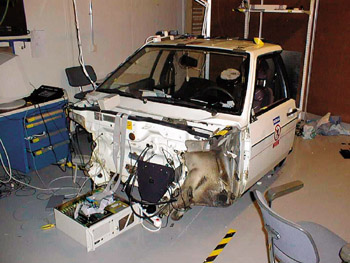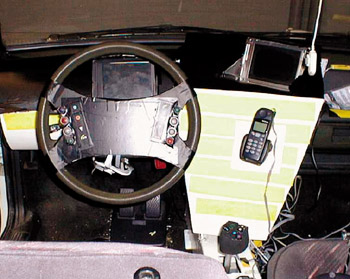On the Track
|
|
While Steering Wheel ran its course, the Samara was used to conduct several tests. It was repeatedly equipped with different control elements for call handling. The positions of different physical control elements were assessed. Solutions based on voice recognition were compared to a user interface with buttons. Eventually a complete integrated UI simulation was built into the Samara. Let’s look a bit closer at one of the tests conducted, designed to facilitate text entry during driving.
Writing while driving presents the designer with conflicting aims. It is obviously dangerous to write while driving a vehicle, so perhaps a solution encouraging it shouldn’t be designed at all. On the other hand, some drivers write anyway. They write with devices that were not intended for use while driving, such as the keys on a mobile phone or a pen and a pad of paper. So perhaps it would be better to offer a solution after all, a solution optimized for use while driving. Text entry does not necessarily involve long messages. It is more often needed when, for example, recording a name or an address. It is also needed when searching for place names in the navigator’s memory or for names of people in the mobile phone’s phonebook. Keying in just a few letters can simplify and accelerate the search substantially. Without taking a stand on the acceptability of entering text while driving, we decided to conduct trials of what can be done so that writing needn’t disrupt driving as much as it does with today’s devices.

Figure 9.3 : Another view of the Samara is ready for the track.
In one of these trials researcher Jarkko Ylikoski added voice feedback to the buttons of a normal ITU-T standard phone keypad. A synthesizer read the letter aloud as soon as it was entered. After a user keyed in the space button, the synthesizer would read the entire word. She could also replay the last three words entered by pushing the star button. Voice feedback realized this way supported writing on the level of individual letters. The spelling of a word could be checked after the whole word was completed, and listening to the last words entered helped recall the context if the message was interrupted by traffic. On the basis of this idea, we constructed a simulation whereby the phone was connected to a PC that produced the voice feedback, and installed it in Samara’s dashboard (Figure 9.4).
During the test, subjects were asked to drive and write simultaneously. The texts to be written were short, one- or two-word names and addresses with letters and numbers. The same tasks were performed with and without voice feedback (see Figure 9.5). We registered no difference between the voice feedback and standard solutions as measured by the established quantitative usability criteria, specifically, the speed of the performance and the number of mistakes. In addition to the established usability criteria, we also considered the length of time that drivers were out of their lanes while performing the writing task. This measurement was used to assess the extent to which the handling of the phone interfered with the primary task of steering the Samara. The actual measuring was done after the test by analyzing videotapes. It indicated that voice feedback had a very significant effect on the drivers’ ability to stay in their own lanes.

Figure 9.4: The condition of Samara’s cabin at the time of the writing test. The writing task was done using a Nokia 5110 phone, which was connected to a PC to produce voice feedback and to control the display. The buttons on the steering wheel and the LCD displays are in the cabin for other tests.
One problem yet remaining was that the driver had to visually focus on the keypad now and then in order to find the correct buttons to push. With a 3 x 4-keypad layout it is possible to use the keys solely on the basis of memory or by touch, but few phone users have learned to do that so well that they can do without visual supports. Simultaneous concentration on steering and writing increased the user’s mental taskload to the point of discomfort. Thus the subjective evaluations about voice feedback were positive, but not as enthusiastic as we would have hoped according to the quantitative measurements.

Figure 9.5: The duration of straying from the driving lane during the writing task. The bar on the left indicates the duration of straying when the writing task is not supported with voice feedback, which is the situation with today’s phones. The bar on the right indicates the situation where writing is supported with voice feedback on a letter level, word level, and sentence level. The duration of straying has decreased by more than half.
|
|
EAN: 2147483647
Pages: 142